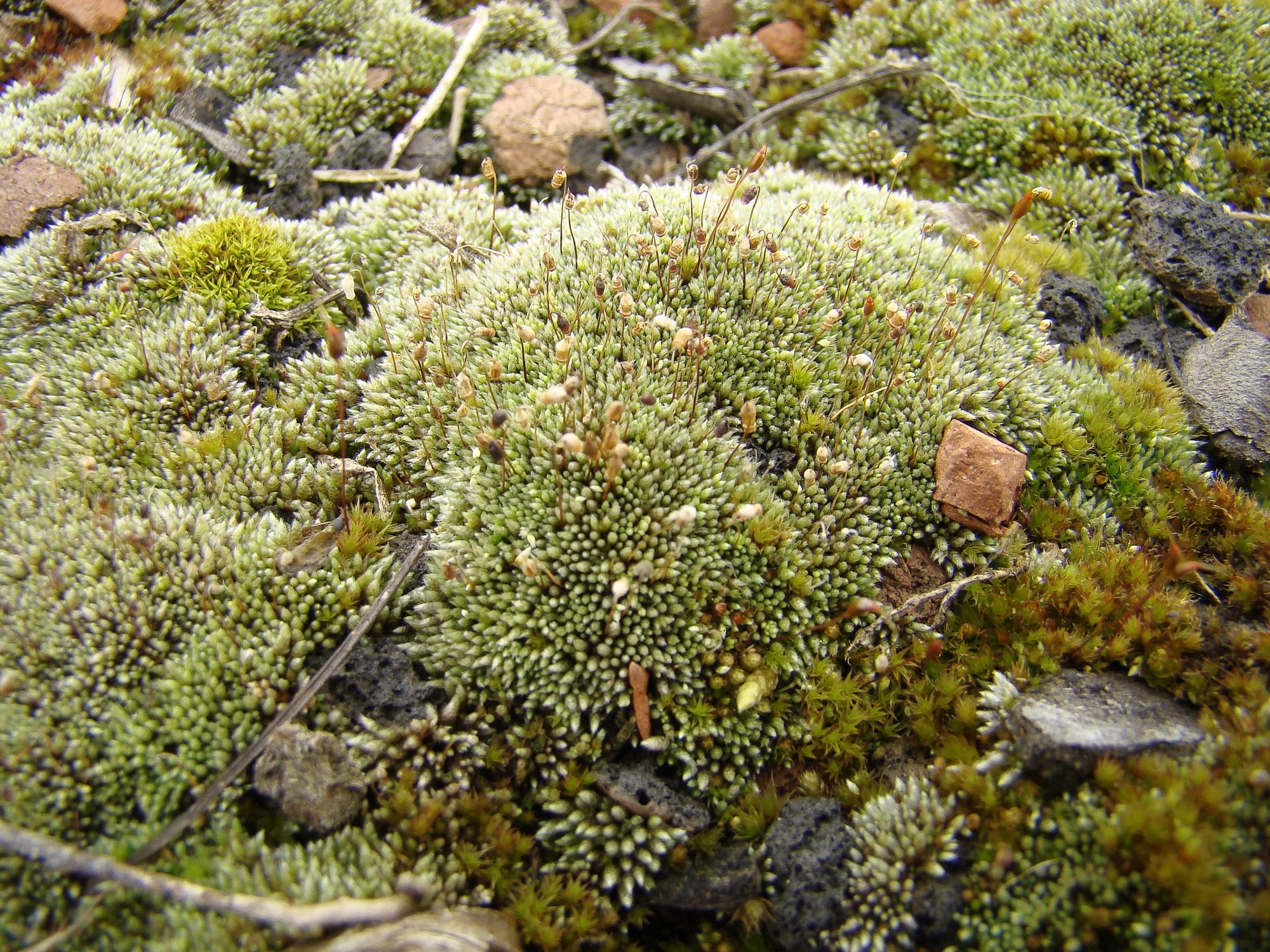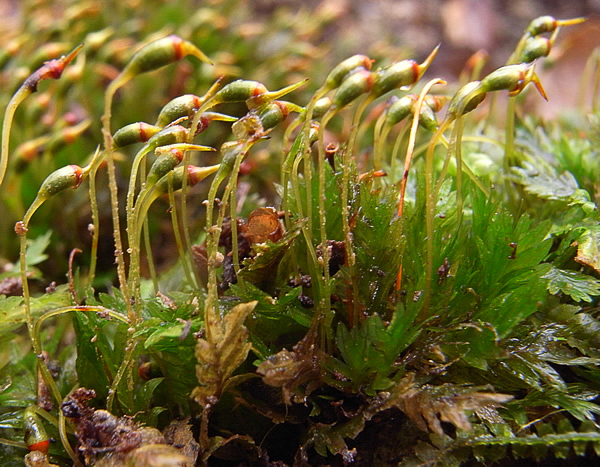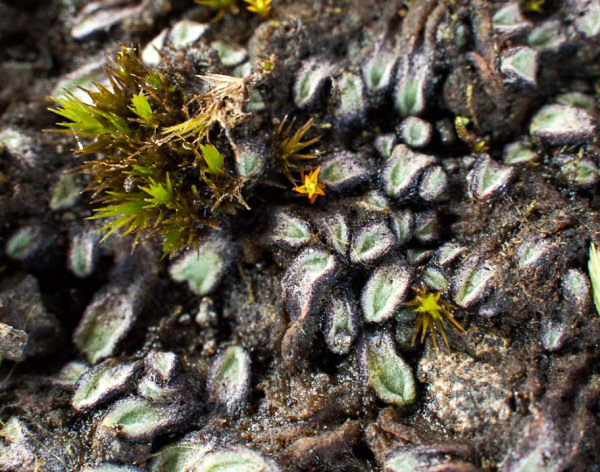What is a bryophyte?
Bryophytes are a group of plants that include mosses, liverworts and hornworts. Currently (January 2021), there are 1098 species of bryophyte in Britain and Ireland, which represents around 58 percent of the total European flora. Conversely, our islands have less than 20 per cent of the European flowering plants.
Like the ‘higher’ plants (flowering plants and ferns) the majority of bryophytes make their own food via photosynthesis and because they contain chlorophyll, the majority are green. However, bryophytes lack proper roots, structural strength and an advanced vascular system to move water and dissolved substances around efficiently and so are size-limited.
The mosses, liverworts and hornworts are believed to have evolved from ancestral green algae and are thought to comprise the earliest lineages of plants. Because of their unassuming nature and small stature, bryophytes are easily overlooked or even dismissed as boring, but their beauty and complexity under the microscope easily puts them on a par with their higher plant relatives.
Mosses
Mosses may be small, but they pack a lot of structural detail into a small package. The 20,000 species worldwide range from being microscopic to over a metre; they may be upright, or creeping and much branched. They may grow in streams or deserts, on mountain tops or in sea spray, from the antarctic through tropical rain forests to the arctic, and in fact just about anywhere except in the sea itself. Moss leaves are very thin; in many they are only 1 cell thick. Because of this, many mosses have evolved complex and beautiful leaf structures to minimise desiccation and maintain photosynthetic efficiency. Leaf teeth, plates of tissue (lamellae) overlying nerves and borders are common examples. Leaf cells often have minute projections, called papillae, which also play an important role in water relations.
Liverworts and hornworts
Liverworts number around 5000 species worldwide. They may also have thin leaves like the mosses (the so-called leafy liverworts). Or they may form green plates of apparently leafless tissue, in which case they are called thallose liverworts. It is probable that mosses, liverworts and hornworts are not at all closely related, being united only by sharing their peculiar life-cycle.
Many liverworts are tolerant of repeated cycles of wetting and drying and this makes them particularly successful epiphytes of other plants. Like many mosses, leafy liverwort leaves are usually only one cell thick and they too have evolved fascinating and often complex structures to maintain water relations. The intricately lobed leaves of e.g., Radula, Frullania and Scapania are unique to the leafy liverworts.
The hornworts are a much smaller group of plants, numbering around 150 species wordwide. Hornworts resemble thallose liverworts, but have horn-like spore-producing structures unlike the capsules of either mosses or liverworts. All hornworts have also symbiotic internal colonies of Nostoc, a cyanobacterium, which reveals itself as dark spots within the thallus.
Habitats
Bryophytes occupy many different kinds of habitat. Many are generalists or opportunists, able to colonise many different kinds of situation rapidly. Some are tolerant of high levels of disturbance and/or nutrient enrichment and in this group can be found many ubiquitous urban species such as Bryum argenteum and Barbula unguiculata.

Others require more permanent situations, such as long-lived woodland or mires, whilst a substantial number are habitat specialists, found only in certain situations, such as on coastal rocks, in fens, on trees in the flood zone of silty lowland rivers, or on mountains at high altitude.
The diversity of the bryophyte flora of the British Isles is very high, and it attracts bryological researchers and tourists from around the world. The geographic position of Britain and Ireland, its moist and temperate climate, varied geology and clean air all contribute to this. Western parts of Scotland, North Wales and Ireland have a particularly wet and mild climate due to the proximity of the North Atlantic Gulf Stream and support many rare bryophytes as a result. The almost frost-free climates of south-west Ireland and south-west England are home to other, warmth-loving species more commonly associated with southern Europe.
Life cycle
All bryophytes share a fundamentally similar life-cycle where a relatively long-lived, free-living leafy part (the gametophyte) alternates with a short-lived spore-producing part (the sporophyte) which never detaches from the gametophyte and is in fact dependent on it for food. The gametophyte traps light energy and converts it into food for both generations.
Male and female structures (antheridia and archegonia) develop on the mature gametophyte and fertilisation produces the sporophyte, represented mainly by the capsule (which produces spores) and its stalk (seta). Spores are then produced in the capsule and they disperse and germinate to develop into the gametophyte once more.

Antheridia
One of the most attractive moss structures is found in its capsule, if it produces one (not all species do). When the spores are ripe and ready to be released, the lid of the capsule falls off, but the release of spores is usually controlled by a fringe of flexible teeth around the capsule mouth. These are the peristome teeth (peristome means ‘around the mouth’) and they are as varied and beautiful as any flower, but very much smaller.
Moreover, they move as they are watched, since small currents of air cause changes in humidity, making the teeth flex in and out. These movements assist in the most effective distribution of spores, flicking out small quantities when air conditions are right, and stopping the process when they are not. Look at a ripe moss capsule with a hand lens, and your breathing will make the teeth flex.

Asexual propagules
Not every bryophyte produces spores. In the plant world, bryophytes are relatively unique in the specialised asexual propagules produced by many species of moss and liverwort. Many also possess the highly unusual ability to reproduce vegetatively from fragments of almost any part of the gametophyte.
Asexual propagules are of two main kinds and both can be important to bryologists in identification. Gemmae are small, unicellular or more commonly, multicellular structures with undifferentiated cells. They are often distinctive, with shape, size, pigmentation etc. peculiar to a particular species. They may be found at shoot tips, on leaves or in leaf axils and on the plant’s rhizoids (root-like structures). Bulbils, deciduous branchlets, and other propagules are typically larger and comprise differentiated cells.
Leaf fragments are produced by many bryophytes and each fragment has the ability to develop individually into a genetic clone of its parent.

Clustered within the leaf are large, globular gemmae. The plant is at an early stage of dessication, indicated by the partially collapsed (concave) cell walls of the leaf and gemmae. Small, nipple-like papillae that ornament the outer surface of the leaf cells in this species are noticeable on the lower side of the leaf surface.
What’s the difference between a moss and a leafy liverwort?
This is a commonly asked question and, unfortunately, not a straightforward one to answer. Certain structures are found only in leafy liverworts – complicate-lobed leaves, underleaves, oil bodies and cell wall corner thickenings (trigones) for example. Whether they are present or not depends on the species though. Conversely, leaf nerves are only found in mosses, but not all moss species have nerved leaves.
When sporophytes are present, there are obvious differences between those of mosses and leafy liverworts. Moss capsules and setae tend to elongate and develop slowly (sometimes taking months to mature) but look strong and often remain attached to the gametophyte long after the spores have dispersed. Their capsules release spores either through an obvious opening at one end, which is sealed by a lid until they are mature, or the walls of the capsule just disintegrate, releasing the spores (cleistocarpous mosses). Conversely, liverwort sporophytes develop rapidly – in a matter of days or weeks – but are weak-looking and do not persist beyond maturity. When the spores are ripe the capsules open like a valve, along four lines of weakness.











